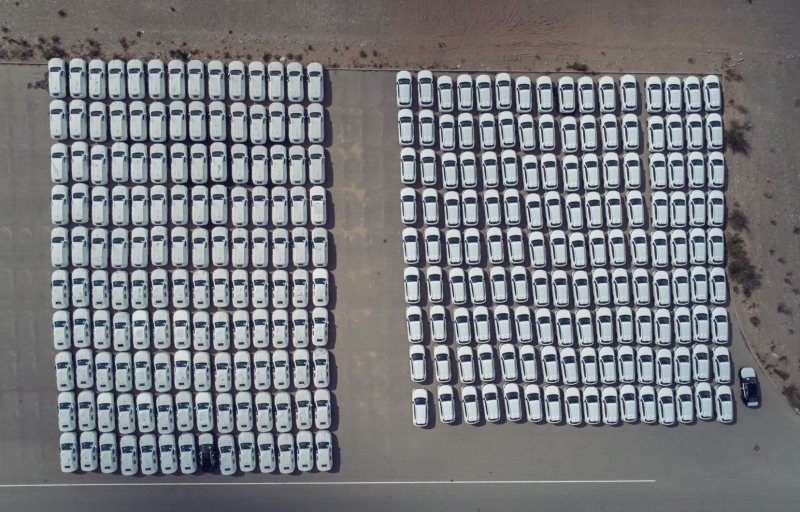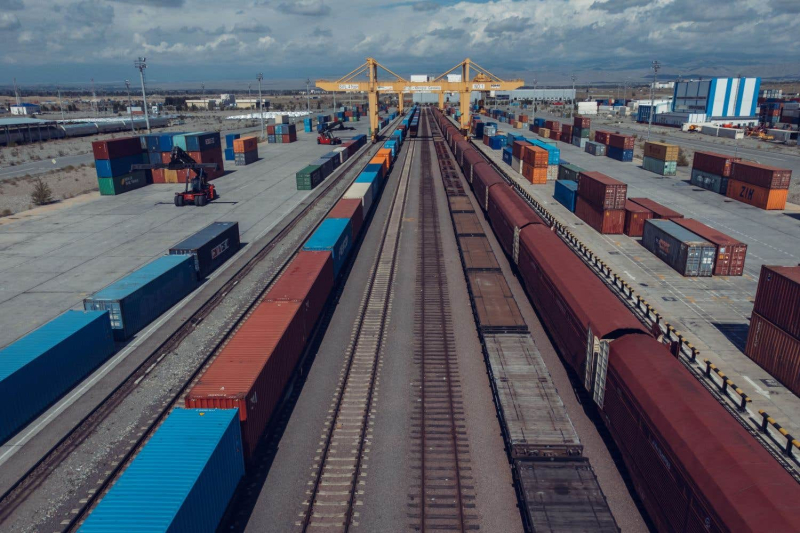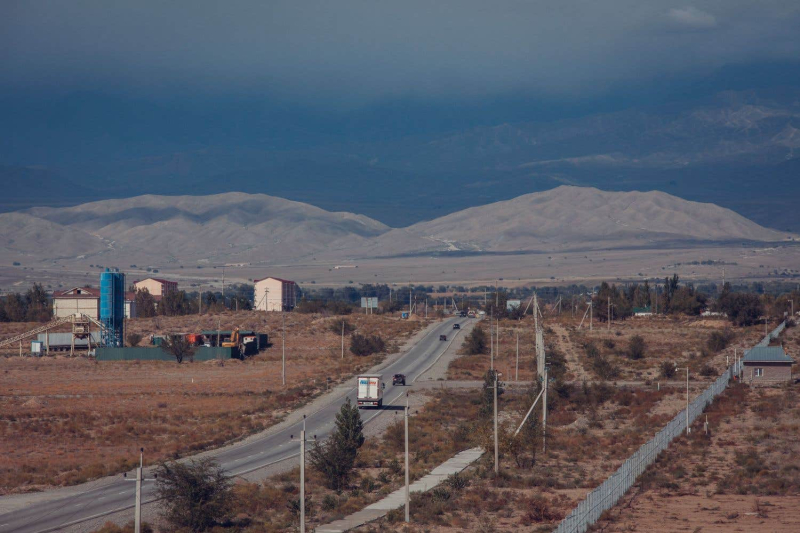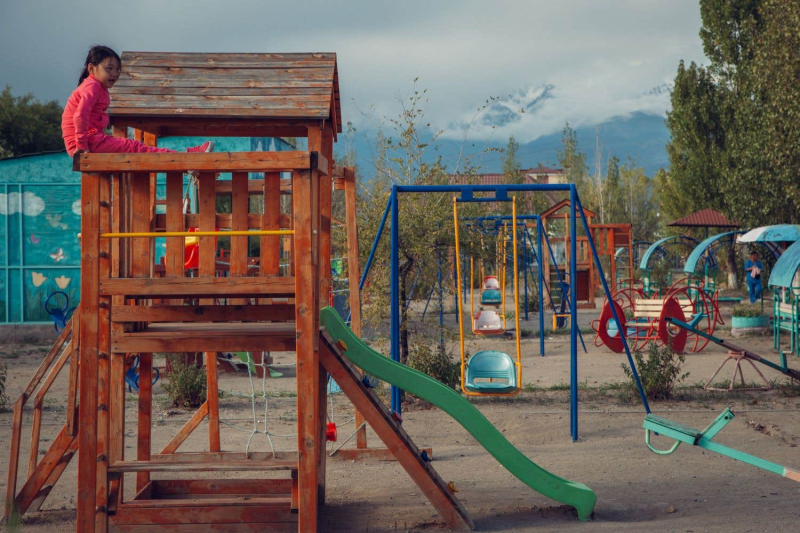
Valérian Mazataud Le Devoir Nearly 15,000 cars are stored in the dry port of Khorgos, in Kazakhstan, a few kilometers from the Chinese border. In recent years, Chinese electric automobiles have taken markets in Central Asia and Russia by storm and every spare space at the port seems to be used to store them.
In 2013, Chinese President Xi Jinping launched the titanic New Silk Roads project, officially called the Beltand Road Initiative< /i>. Since then, some 150 countries have joined the initiative, which aims, among other things, to build roads, railways and ports to facilitate trade with China. Ten years later, Le Devoir visited Kazakhstan and Uzbekistan, two countries at the heart of these new trade routes. First in a series of eight travel journals.
In the middle of arid lands, in a desert that stretches as far as the eye can see, a gigantic port suddenly appears, bordered by no water. Where, just eight years ago, there were only dunes, surveyed by horsemen watching over their livestock, now nearly a thousand containers pass through every day, veritable Ali Baba's caves stuffed with Chinese goods.
Flagship project of the Belt and Road Initiative (BRI), the dry port of Khorgos, located in Kazakhstan, a few kilometers from the Chinese border, has become, since its commissioning in August 2015, a key transit point for goods leaving China by rail to conquer the European market.
It is at this point of junction between the Middle Kingdom and Central Asia, where caravanners from the East and West once met to trade while exchanging ideas and knowledge, that we begins our epic journey on the new Silk Roads. A journey that will extend over more than 2000 kilometers, to see and understand the repercussions of this “project of the century”, as it was described by Beijing, in Kazakhstan and Uzbekistan, two landlocked former Soviet republics, but become, through their geographical position, key players in Chinese excess.
“There is a train from China that has just left and two trains from Kazakhstan that are due to arrive,” says Aidar, one of the Khorgos dry port dispatchers, confidently in his office overlooking the 129-hectare site. Behind his four computer screens, with three telephones and two walkie-talkies at hand, the man manages the traffic of trains that must necessarily stop at the port, located, not without irony, near the farthest point on Earth from all ocean.

Photo: Valérian Mazataud Le Devoir In China and Europe, the gauge of the rails is 1,435 millimeters, while in the former Soviet bloc countries, it is 85 millimeters wider. This difference in size requires the transshipment of all containers from Chinese trains to Kazakh trains before being able to continue their journey to Europe.
“In China and Europe, the rail gauge is 1435 millimeters, while in the former Soviet bloc countries it is wider, at 1520 millimeters,” Asset Seisenbek, deputy general director of the special economic zone, tells us. Khorgos-Eastern Gates. A difference of only 85 mm, which nevertheless requires the transshipment of all containers from Chinese trains to Kazakh trains so that they can travel along the rails of the former Soviet republics and reach the gates of Europe before leaving. to be transhipped once again, this time on European trains.
Two routes are used: the Trans-Siberian Corridor, which leads to Russia and which is experiencing a slowdown due to sanctions imposed by the West, and the Trans-Caspian Corridor, which crosses the Caspian Sea and then reaches Turkey — which has been growing rapidly since the start of the war in Ukraine. In the first quarter of 2023, rail freight volume in this corridor jumped 64%.

Photo: Valérian Mazataud Le Devoir The town of Nurkent, a few kilometers from the port, was built to house its employees. At the moment, only 3,000 people live there, but eventually the city could accommodate 100,000 inhabitants. Furnished accommodation is offered free of charge to port workers and customs service workers.
Logistics
Under a scorching sun, Gaziz Omirbek, the director of the commercial department of the dry port of Khorgos, shows us around the place, inevitably talking about the complex logistics for which the site is famous. “It takes us about an hour to transship an entire train,” he explains through the thunderous noise of immense cranes which hook, one after the other, the containers strewn on Chinese trains to lift them to using pulleys, move them on overhead rails and place them, a few meters further, on Kazakh trains. “We operate 24 hours a day thanks to 450 workers,” continues the man. Every day, a dozen trains, each carrying 50 to 60 containers, arrive from China. »
Everywhere around, blue, red and orange containers are piled up to form veritable colorful walls in the middle of the desert. “Sometimes we miss Kazakh trains,” he explains, forcing cargo to stop at the dry port, where 18,000 containers can be stored. Inside are crammed with a multitude of consumer products, countless electronic devices and a growing number of Chinese electric cars, which have literally taken the markets of Central Asia and Russia by storm in recent years thanks to their competitive prices.

Photo: Valérian Mazataud Le Devoir The flagship project of the Belt and Road initiative, the dry port of Khorgos, located in Kazakhstan, a few kilometers from the Chinese border, has become, since its commissioning in August 2015, a key transit point for goods leaving China by rail to conquer the European market.
Every free space on the site is also used to store cars, before they continue their journey. When we visited, some 15,000 carefully lined up Chinese vehicles were scattered across the asphalt that now covers the desert. An eloquent image of the fervor of the Chinese automotive sector.
Shortcut
For Asset Seisenbek, Kazakhstan offers an undeniable geographical advantage by being located in intersection of civilizations, cultures and economies. “I firmly believe that logistics is the new oil of Kazakhstan,” he says with conviction. Everything starts from the roads, they are the veins of our economy. »
The rail route allows Chinese goods to reach Europe in 14 days. By sea, the journey, although less expensive, is three times longer, spanning a period of 40 to 60 days. An undeniable advantage which was amplified during the pandemic, making the dry port of Khorgos essential.
“One of the only modes of transport [authorized] between China and Europe was, at that time, the railway,” he recalls. If we had not had the infrastructure in place in Khorgos, consumers in Central Asia and Europe would have suffered. »
Since its commissioning, the port of Khorgos has continued to grow. From the 4,339 TEUs (20-foot containers) that passed through the dry port in 2015, the volume increased to 340,000 TEUs in 2022. “Our facilities have an annual capacity of 540,000 TEUs. We should reach this volume within a year or two,” says Mr. Seisenbek, speaking of expansion projects already on the table.

Photo: Valérian Mazataud Le Devoir The dry port of Khorgos and the town of Nurkent, on the left, were built in the middle of the arid lands of a desert which extends to foot of the Tian Shan mountain range.
Unlike many other infrastructures of the new Silk Roads, the port of Khorgos was not built with Chinese funds, but rather thanks to the Nurly Zhol infrastructure program (“Bright Path” in Kazakh), launched in 2014 under former President of Kazakhstan Nursultan Nazarbayev.Today, the port is 51% owned by KTZ, the Kazakh railway company, and 49% by Chinese interests, namely the state company Cosco Shipping Lines and the port of Lianyungang. Conversely, the port of Lianyungang, in China, bordering the Yellow Sea, where many maritime freights leave, is 51% owned by Chinese interests and 49% by Kazakh interests.
< h2 class="h2-intertitre">Tax holiday
But everything is not optimal. Currently, many trains returning to China through the port of Khorgos are empty. So that these passageways — leading to the Chinese market in the east, the European market in the west and the Russian market in the north — benefit the local economy, a special economic zone, offering a tax holiday to companies that settle there, was created. In this 225-hectare industrial park adjacent to the port, buildings housing production lines and warehouses pierce the asphalt. More than forty companies, Kazakh, Chinese and others, are established there. We are told that the doors are also open to Russian companies seeking to relocate due to Western sanctions.
At the entrance to the SSA Feed Mills warehouse, which produces around 50 types of animal food, a bus waits for workers to take them home at the end of their shift. “We settled here in 2020 because we are close to China, we have efficient rail connections that allow us to deliver everywhere in Kazakhstan and we are exempt from taxes,” explains Bakytgali Alirakhym, who manages the warehouse.
Currently, the company does not sell its products in China, but it is actively coveting this market. “Who doesn’t hope to do business with China? » says the foreman jokingly, in the shadow of six huge metal silos where the company, which hires 45 employees, stores grains.
A little further, by talking with the director of the company Miami Solar, which manufactures solar panels, we understand that certain companies are established there not to do business with China, but rather to take advantage of the logistics of places. “We are trying to obtain certification to sell our panels in the United States,” says Rakhimzhanov Aidos. With rail connections, it is a good place to export our products to the Chinese port of Lianyungang, where they can be loaded on cargo ships to the United States. »
Nurkent
Outside the factory, a yurt, a vestige of the nomadism that has defined the life of Kazakhs for decades, welcomes workers. But it is generally rather in Nurkent, a town emerging from the ground three kilometers from the entrance to the port, that many employees have taken up residence.
Some 3,000 people currently live there, but Nurkent should eventually accommodate 100,000 inhabitants, according to government plans. Fully furnished accommodation is offered to port and customs service employees. “We even provide the slippers! » said Asset Seisenbek smiling.

Photo: Valérian Mazataud Le Devoir A little girl has fun playing games at Nurkent primary school. To attract employees to the middle of the desert, in addition to housing provided free of charge, they are also given access to all the services necessary for families.
The streets of Nurkent are like those of many other cities. At the end of a September day, parents and children enter and leave the two-story school. “I like living here,” says Guldana, 30, a customs officer at the Khorgos border post. My three children were born in Nurkent. They go to school right here,” she said, pointing to the building behind her. “My family is staying for free. »
“We have everything we need,” adds Agdal, a 46-year-old locomotive driver, who also met near the school. The father of four also benefits from free accommodation. “Life is good here,” he assures. In this desert now bathed in an ocean of modernity, laughter, tears and memories begin to take root along these new trade routes.
With Naubet Bisenov
This report was financed with the support of the Transat- International Journalism Fund Le Devoir .
Monday: Kazakhstan, stuck between the Russian bear and the Chinese dragon

